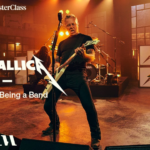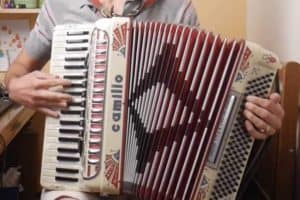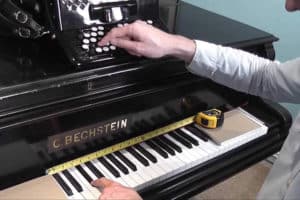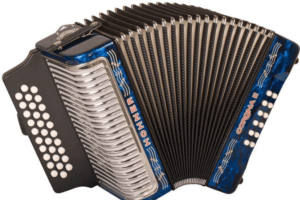While accordions are relatively easy to learn, not everyone is willing to purchase and learn them. If you’re looking for accordion-like instruments, I got you covered. In this article, you’ll discover the different types of accordions and instruments like an accordion.
One of the popular substitutes for an accordion is the concertina. It’s a free-reed musical instrument, specifically a wind instrument, just like an accordion and a harmonica. It consists of a bellows that contracts and expands to force air past free reeds to produce sound. It also has a series of buttons or keys on both ends, unlike accordion buttons on the front of the instrument.
Read on to learn more about the different types of accordions and their possible alternatives.
16 Types of Accordions
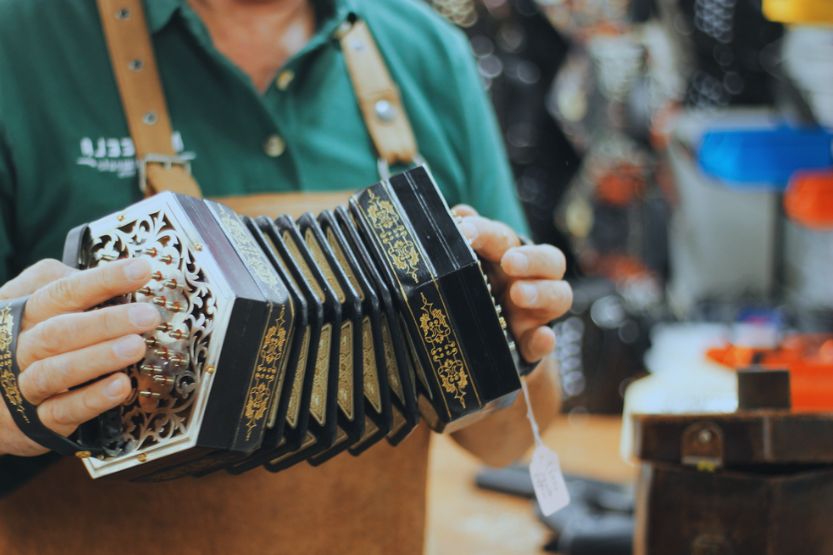
Before exploring accordion-like musical instruments, you might want to check out other types of accordions first. Who knows, you might find one that you’d like to try:
1. Bandoneón Accordion
The bandoneón (also spelled bandonion)—or button accordion—is a hand-held, bellows-driven free-reed instrument. Carl Friedrich Uhlig invented it in the early 18th century.
Initially, it was referred to as a “poor man’s accordion” and was usually a substitute for percussion and string instruments.
The accordion and bandoneón are both hand-held bellows-driven free-reed musical instruments. You usually play the bandoneon by resting it on one or both of your legs. Meanwhile, you can adjust the straps of a lightweight accordion to allow it to rest lightly on one or both of your legs.
The main difference between the two instruments is the sound they produce. The bandoneón is typically chromatic, meaning it has all twelve-octave notes. The accordion can be chromatic or diatonic.
2. Bayan Accordion
The bayan is a Russian name for any chromatic button accordion. P. Sterligov developed it in 1907 and named it after an old Russian poet-singer, ‘Boyan.’ The original bayan features 72 basses (with preset chords) and 55 treble buttons (4 rows).
The bayan holds some differences in construction from Western chromatic button accordions. For instance, it has a rectangular (as opposed to trapezoidal) and broader set of reeds.
And instead of being arranged in pairs, the reeds are usually attached in big groups to a standard plate, which is screwed to a reed block.
3. Bisonoric Accordion
The bisonoric accordion is popularly known as the eight-bass bellows (‘oito baixos’) in Brazil’s northeastern region. Unlike the Unisonic accordion, it creates two or more different notes or pitches, depending on the direction of the movement of the bellows.
For instance, if you pull out the bellows, it makes a different note or pitch. The same thing happens if you push the bellows in.
The melody side of the bisonoric accordion is usually played by the right hand, while the bass side is traditionally played by the left hand. Two different sets of reeds connect both sides. That’s why they produce a different sound.
4. British Chromatic Accordion
The British Chromatic accordion is special in mainstream and traditional Scottish music. The right-hand side of the accordion uses the bisonoric system, while the left-hand side uses the Stradella bass system (also known as the standard bass).
The Stradella bass system is the most common layout of the button board for accordions. This easy-to-learn system uses rows of buttons arranged in a circle of fifths/fourths. This arrangement puts the primary major chords in three adjacent columns.
5. Button Accordion
As its name suggests, the button accordion has several buttons on its melody side (usually the right).
This makes it different from the piano accordion, which comes with a piano-like keyboard on its right side. It can effectively play all kinds of songs that you usually play on a traditional piano accordion.
Most models of button accordions are recognized for their portability. They’re also excellent for beginners and people with zero background in playing other musical instruments.
6. Chromatic Accordion
In 1850, Franz Walter created the chromatic accordion while readjusting the reeds of a three-row diatonic. This accordion is highly popular in Europe and Russia (called ‘bayan’), but it doesn’t enjoy the same popularity in the United States.
The chromatic accordion has a more extensive range than its piano-style counterparts. The modern version of this type of accordion has 160 bass buttons (left side) and up to 6 rows of treble buttons (right side).
Every row can effectively play consecutive chromatic notes or notes that aren’t in the scale you’re playing.
7. Diatonic Accordion
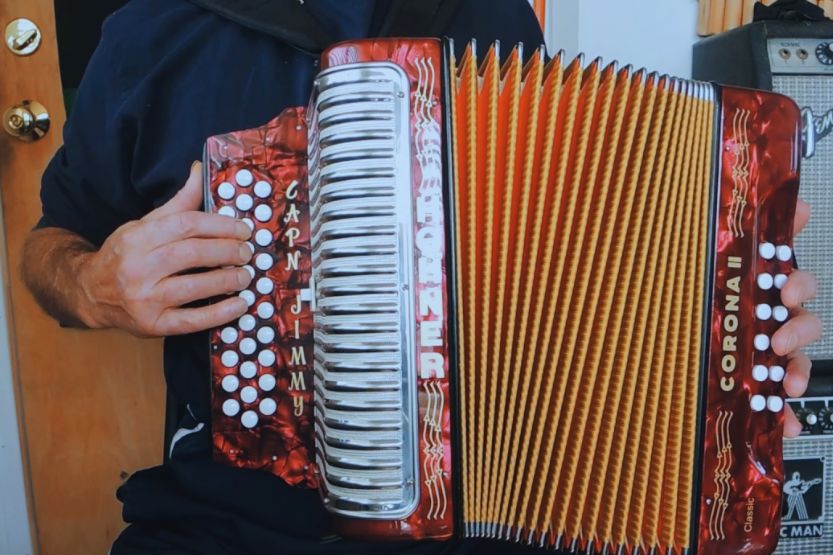
Many folk dance performance groups widely use the diatonic accordion because it’s affordable, lightweight, and produces excellent sound.
One thing that distinguishes it from the chromatic accordion is it comes with bisonoric reeds, which produce different sounds every time the bellows are pulled in or pushed out.
Several types of diatonic accordion exist today:
- One row diatonic (sometimes called the “German-style accordion”)
- Two-row diatonic accordions
- Three-row diatonic accordions
- Organetto
- Italian Diatonic
- Shand accordion
- Helikon accordion
8. Digital Accordion
As the name says, a digital accordion produces synthesized, or electronic accordion sounds through digital methods.
It has the common control features of a traditional accordion, such as bellows, left-side bass buttons, and a right-side, piano-style keyboard (or buttons). Unlike non-digital accordions, it can change the layout of the keys, tunings, and sounds produced on both sides.
Since most digital accordions don’t create sounds within their sound module, they need to be plugged into an external sound module (e.g., keyboard amplifier, PA system, and speaker).
Pressing the keys produces Musical Instrument Digital Interface (MIDI) messages, which can trigger sounds.
9. Pedal Harmony Accordion
The pedal harmony accordion consists of two-foot pedals with pumps (attached to the accordion by a metal pipe), two partitions, 24 left-hand buttons, a keyboard with three rows, and a bellows. Step on the pumping pedals to introduce air into the instrument to start playing it.
The pedal harmony accordion is much louder than other types of accordions. It’s also easier to use because you can play while sitting.
Because of its loudness and unique design, you can play it for hours without getting tired.
10. Piano Accordion
European immigrants found the first piano accordion in the United States. Contrary to its name, it creates sounds more similar to that of an organ instead of a piano.
Since a piano is a percussion instrument and an organ is a woodwind instrument, they produce highly different sounds.
As its name suggests, the piano accordion comes with a piano-style keyboard. Although the keyboard is usually on the ride side, you can have it modified for left-handed use if you’re naturally left-handed.
Again, what is an accordion-like instrument? Concertina, a free-reed musical instrument, is an accordion-like instrument since it has expanding and contracting bellows. But, its buttons are on both ends. This instrument was developed in England and Germany.
11. Russian Garmon
The Russian Garmon got its name from “garmonika,” a Russian word for “harmonics.” On its right side, it has two rows of diatonic buttons. The primary chord and relative harmonic minor are on the left.
It has two major types, further divided into other local garmons. The unisonoric Russian garmon includes the “livenka” and the “khromka.” Meanwhile, the bisonoric Russian garmon consists of the “talyanka” and the tula accordion.
12. Schrammel Accordion
The Schrammel accordion is the predecessor of the modern chromatic accordion. It has a right-hand melody keyboard in the chromatic B-Griff system, which means the “C” is located on the third row and the “B” is on the first row. It also comes with a twelve-button diatonic bass keyboard.
Even though it only has twelve bass notes, it won’t limit your performance because you can combine several buttons simultaneously to make different types of chords. And compared to most modern chromatic accordions, it produces a more distinct or special sound because it’s lighter and smaller.
13. Swiss Organ
The Swiss Organ (Schwyzerörgeli) was initially invented in Vienna. It came to Switzerland in the 1830s and was widely used in Swiss folk music. It doesn’t enjoy the same popularity outside Switzerland and is challenging to find.
The earlier version of this diatonic button accordion came with a single row of melody buttons (melodeon), which eventually gave way to a three-row box.
Today, the Swiss Organ accordion usually comes with 18 bass buttons (arranged in two rows) and 31 right-hand treble buttons (arranged in three rows).
14. Steirische Harmonika
The Steirische Harmonika, also known as the “Ziach,” is a button accordion. It’s still widely used in the folk music of different countries and provinces, including Austria, Slovenia, South Tyrol (an area in Italy), and the Czech Republic.
As a bisonoric accordion, each button creates a different note whenever you push or pull the bellows. Its louder and richer bass notes are separated from other diatonic accordions called “Helikonbässe.”
This is because it has larger reeds, age-hardenable aluminium (duraluminium) reed frames, and a chamber specifically designed to amplify bass notes.
15. Trikitixa Diatonic Accordion
The trikitixa diatonic accordion was developed in Vienna, Austria, in 1829. It came to Europe early to mid-19th century through French or Italian railway workers from the Alps.
The Basque version of the trikitixa diatonic accordion differs from its piano-style and chromatic button versions. It is usually smaller and comes with 23 right-hand and 12 left-hand buttons.
Plus, the buttons on the right side of the accordion produce two distinct notes, depending on the bellows’ direction movement.
16. Unisonoric Accordion
A unisonoric accordion typically has 120 buttons with a Stradella bass system button layout. Unlike a bisonoric accordion, it produces the same note or pitches no matter what direction you push or pull the bellows. The pitch of this accordion will also depend on its size.
6 Alternatives to Accordions
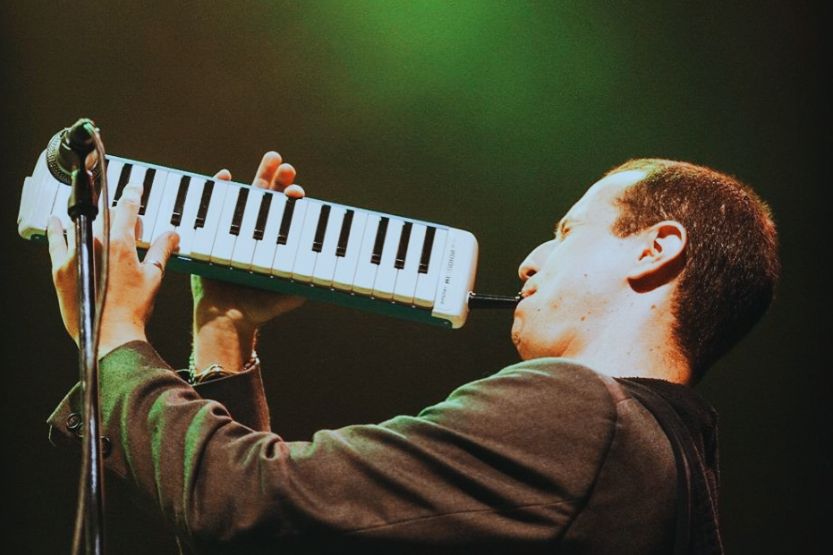
1. Concertina
There are various types of concertinas on the market. Depending on the type you use, this accordion-like instrument is relatively easy to learn. Most of them are frequently used as an accompaniment for folk music and casual music events.
Most concertinas are hexagonal (six sides) or octagonal (eight sides) in shape. They belong to the same musical instrument family as accordions and harmonicas—the free-reed instruments. Like their accordion cousins, they come with bellows, keys (or buttons) on both sides, and a pair of reeds.
2. Melodica
The melodica, a hand-held wind instrument, was invented by Hohner in the 1950s. It’s known by different names: blow-organ, key-flute, or even hooter (the inspiration behind The Hooters’ band name).
Melodicas are relatively easier to play because they’re light and portable. You can hold them like a trumpet, with your right hand playing the keys.
You blow air into the instrument through a mouthpiece using a light breath for the soft notes and a whistle-like breath for stronger notes. Alternatively, a foot pump can blow air into the instrument.
While it doesn’t have the full range of an accordion, melodicas are still a good substitute for the said musical instrument. They’re probably the equivalent to the keyboard half (more or less) of an accordion.
3. Roli Seaboard
The Seaboard is a Musical Instrument Digital Interface (MIDI) controller keyboard manufactured by the London-based music technology company ROLI. Instead of the traditional lever keyboard, it features a soft, flexible rubber surface with an embedded sensor for playing the keys.
There are plenty of ways to integrate the Seaboard with your digital audio workstation (DAW) and software synthesizer.
You can access the ROLI Studio Player to make great sounds, including an accordion sound. But a word of warning: you might not like the accordion sound because it sounds synthesized.
4. Harmonium
The harmonium is a free-reed keyboard instrument lesser known than its cousin, the accordion. You might know it by these names: melodeon, the Indian accordion, pump organ, and reed organ.
It works similarly to accordions but uses a different mechanism to produce sound. It uses foot-powered or hand-powered bellows to send air through a pressure-equalizing air reservoir, which causes its metal reeds to vibrate and create sound.
The length of the free reeds determines the pitch of the instrument. The volume is controlled by a hand-operated or knee-operated valve mechanism, which creates and regulates the passing air.
In terms of its construction, the harmonium differs from an accordion because it’s typically larger. It looks like a small freestanding piano with two large pedals. Another difference between the two is the harmonium tends to be quieter than an accordion.
5. Clavichord
The clavichord is a (stringed) keyboard instrument, like the accordion and piano. It was widely used in the Renaissance, between the 14th and 17th centuries to the 18th century.
Carl Philipp Emanuel Bach, a German Classical period musician, and composer, considers it the ideal instrument for the Empfindsamer Stil (expressive) musical style.
The shape of the clavichord is typically rectangular. It has a case and piano lid decorated with beautiful inlays like freestanding pianos. It is different from the accordion and other keyboard instruments because it allows some vibrato.
The clavichord has wooden levers, each with a small brass blade called a tangent at the far end of the instrument. They sit just a few millimeters below the clavichord strings.
When you depress the key, the tangent will push up against these strings, splitting them into two parts. This produces vibrations that are transferred through the bridge to the soundboard.
6. Reed Organ
The accordion and reed organ are both members of the reed instrument family. The accordion produces sound because of its freestanding reeds, which are fixed to either side of a reed metal plate.
Meanwhile, the reed organ also operates with the help of free-floating reeds. The free-floating reeds in this musical instrument don’t affect pitch by changing the wind pressure. Thus, it can better express dynamics (differences in loudness between phrases or notes).
How exactly does the reed organ work?
The most common reed organ in the United States is the suction reed organ. Whenever you press down on the instrument’s pedal with one or both of your feet, it causes the bellows to create a “suction” (or vacuum), which is kept in a pressure-equalizing reservoir called an equalizer.
The wind pressure causes the free-floating reeds to vibrate and generate sound.
Conclusion – Accordion-like Instruments
The accordion has a very particular sound, so it’s not surprising that there aren’t many alternatives. Some free-reed musical instruments, such as the concertina, might be suitable substitutes.
But in recent years, accordions are enjoying a resurgence in popularity. Before exploring other accordion-like musical instruments, you might want to check out the different varieties of accordions and enjoy the unique auditory experience.


![The Stratosphere Guitar Parts [Full Review] The Stratosphere Guitar Parts](https://musicalinstrumentpro.com/wp-content/uploads/2021/11/The-Stratosphere-Guitar-Parts-150x150.jpg)

